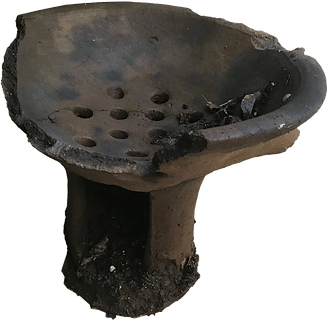Presented by Museum of the Peace Corps Experience and American University Museum
c. 1970s
Choiseul Quarter, St. Lucia
Clay
Assembled, 10 x 8 x 8 in.
Collection, Museum of the Peace Corps Experience
Gift of Deborah Manget, St. Lucia, Choiseul 1978–79
Pictured: replica of original object


In 1978 the Peace Corps sent me to St. Lucia to teach home economics to middle school girls. I felt confident in my ability to teach three of the four subjects. Textiles and sewing, interior design, and child care were familiar to me. The fourth subject, cooking, was going to be a challenge, however. I was not familiar with St. Lucian fruits, vegetables, or protein sources—most of which were prepared with a coal pot, an implement I had never seen before, let alone used. They seemed mysterious to me, ancient compared to the charcoal grills I used in my backyard.
Coal pots are used throughout the Caribbean, but the Choiseul Quarter of St. Lucia is considered the original home of this cooking style. Soon after I arrived, I noticed the smells of charcoal cooking were evident everywhere I went.
Women shape the pots from clay along riverbanks, leaving holes in the lower section. Charcoal is placed in the top bowl of the coal pot and lit from under the holes. Once the coals are red hot, a cooking pot is placed directly on top of them. Ashes fall through the holes to cool in the lower lip, and more coal is added as needed. The deep, rich flavors of the ingredients mixed with earthy, smoky overtones guarantee a delicious meal at any time of day.
My concerns about teaching culinary arts were relieved by my students, who taught me the intricacies of preparing meals with a coal pot. I was glad I turned the tables and allowed them to become my teachers. This improved their self-confidence and created a special bond between people of very different backgrounds. Thanks to my students, I have become an accomplished cook using the coal pot method.
The Committee for a Museum of the Peace Corps Experience is a 501(c)(3) private nonprofit organization. Tax ID: EIN # 93-1289853
The Museum is not affiliated with the U.S. Peace Corps and not acting on behalf of the U.S. Peace Corps.
Museum of the Peace Corps Experience © 2024. All Rights Reserved.